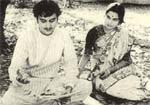Experts tell New Age
 Rabindranath Tagore wrote in a letter to Murari Bhaduri (theatre legend Sisir Kumar Bhaduri’s brother) in 1929 that cinema should ideally be a ‘flow of images’ that should not rely on the written word to communicate. This was even before India’s first talkie Alam Ara had been made.
Rabindranath Tagore wrote in a letter to Murari Bhaduri (theatre legend Sisir Kumar Bhaduri’s brother) in 1929 that cinema should ideally be a ‘flow of images’ that should not rely on the written word to communicate. This was even before India’s first talkie Alam Ara had been made.
Perhaps it is not common knowledge that Tagore in his lifetime had made a film titled Natir Puja in 1932 based on his dance drama bearing the same title. The students of Santiniketan performed in the film, which was shot by two static cameras.
Tagore, however, was not happy with the outcome, neither were those who watched the film in New Theatres.
This was, however, not the first film based on Tagore’s works. In 1923, Naresh Mitra made the silent film Manbhanjan based on Tagore’s short story with the same title. Since then, about 70 feature films including 50 films in Bangla have been adapted from Tagore’s works in the subcontinent.
Only four films- Abujh Bau, directed by Nargis Akhtar, Shasti and Shubha directed by Chashi Nazrul Islam and Kabuliwala directed by Kazi Hayat- have been made in Bangladesh.
‘Films based on works of Tagore are only a handful as the producers do not want to invest money to make classics. Moreover, there are not many talented filmmakers who can make such films,’ film critic Anupam Hayat told New Age.
‘Problem is not only here in Dhaka but also in the sub-continental film industries such as Bollywood and Tollywood. The number of films based on Tagore’s works has decreased drastically in the past four decades even in India,’ he added.
The filmmakers and critics in the country observe that Tagore’s impact on cinema as a medium goes beyond just the stories and songs that have over the years enriched films. Tagore’s literary creations, stories and songs pregnant with emotions and ideas have, of course, inspired filmmakers across the subcontinent.
The poet has also surfaced on a number of occasions in the domain of the pan-Indian Hindi-Urdu cinema, both as a source of stories and a songwriter. Tagore’s influence on cinema has been amazingly wide-ranging.
‘Tagore literature is a wonderful resource for films. Some of his narratives such as Chhinnapatra does not need a lot of work on screenplay to be adapt as a film. His songs are also good for playbacks in Hindi and Bangla films,’ he added.
In Tagore’s lifetime, legendary singer-composer Pankaj Mullick used Tagore songs as playback for the first time in 1937 in Pramathesh Barua’s film Mukti.
‘Tagore’s stories deal with complex human dilemmas and social issues and are often wrapped in layers of abstractions. They have, therefore, never been easy to adapt for the screen,’ filmmaker Murad said.
Yet Satyajit Ray, Tapan Sinha and Rituparno Ghosh have successfully adapted Tagore’s novels and short stories for several of their films, besides frequently turning to his poetry to underscore emotions.
‘Satyajit Ray was perhaps the only filmmaker who could successfully translate Tagore into films. Ray used Tagore’s stories but his films had their own flow of language. He made changes where necessary, for which he was often criticised, keeping the central idea intact’, Murad said.
Going over film adaptation of literature, Murad said, ‘Literal and creative are the two ways to adapt. Needless to say, it takes a gifted filmmaker’s profound understanding of the literary work and the author’s life to be able to accomplish a creative adaptation.’
Bimal Roy’s neo-realist masterpiece Dui Bigha Zameen (1953) in Hindi was inspired by a Tagore poem, Dui Bigha Jomi.
In 1964, Satyajit Ray made one of his finest films, Charulata, based on Tagore’s Noshto Neer (A Wrecked House), following it up in 1987 with another film set in the same setting, Ghare Baire (Home and the World), inspired by a Tagore novel of the same name.
Kumar Shahani brought the novella Char Adhyay (Four Chapters) to the screen in 1977. Theatre director and filmmaker Suman Mukhopadhyay adapted another difficult Tagore novel, Chaturanga (A Quartet of Colours) in 2008.
Tagore’s appeal obviously hasn’t waned a bit in the new millennium. Rituparno Ghosh’s film, Noukadubi (Kashmakash in Hindi), was based on a Tagore novella. It was Ghosh’s follow-up to 2003’s Aishwarya Rai-starrer Chokher Bali, another adaptation of Tagore’s novel with the same title.
Produced by Subhash Ghai, the original version of Noukadubi, was opened only in Bengal. With the Hindi dub, complete with translations of two Tagore songs by veteran lyricist Gulzar, Noukadubi was played in theatres in the rest of India.
The past few years have seen a flurry of films that have drawn upon the Tagore treasure trove, including a 2010 Bengali comedy, Natobar Not Out, starring Raima Sen and debutant Bangladeshi actor Mustafa Prakash.
In 2008, documentary filmmaker Subhrajit Mitra made his maiden feature, Mon Amour: Shesher Kobita Revisited. Inspired by a Tagore lyrical novel, it was cast in the form of a contemporary drama.
Movie-goers believe that more films should be made on Tagore classics in the era when film industries in the world are suffering from shortage of good stories.
-With New Age input




















